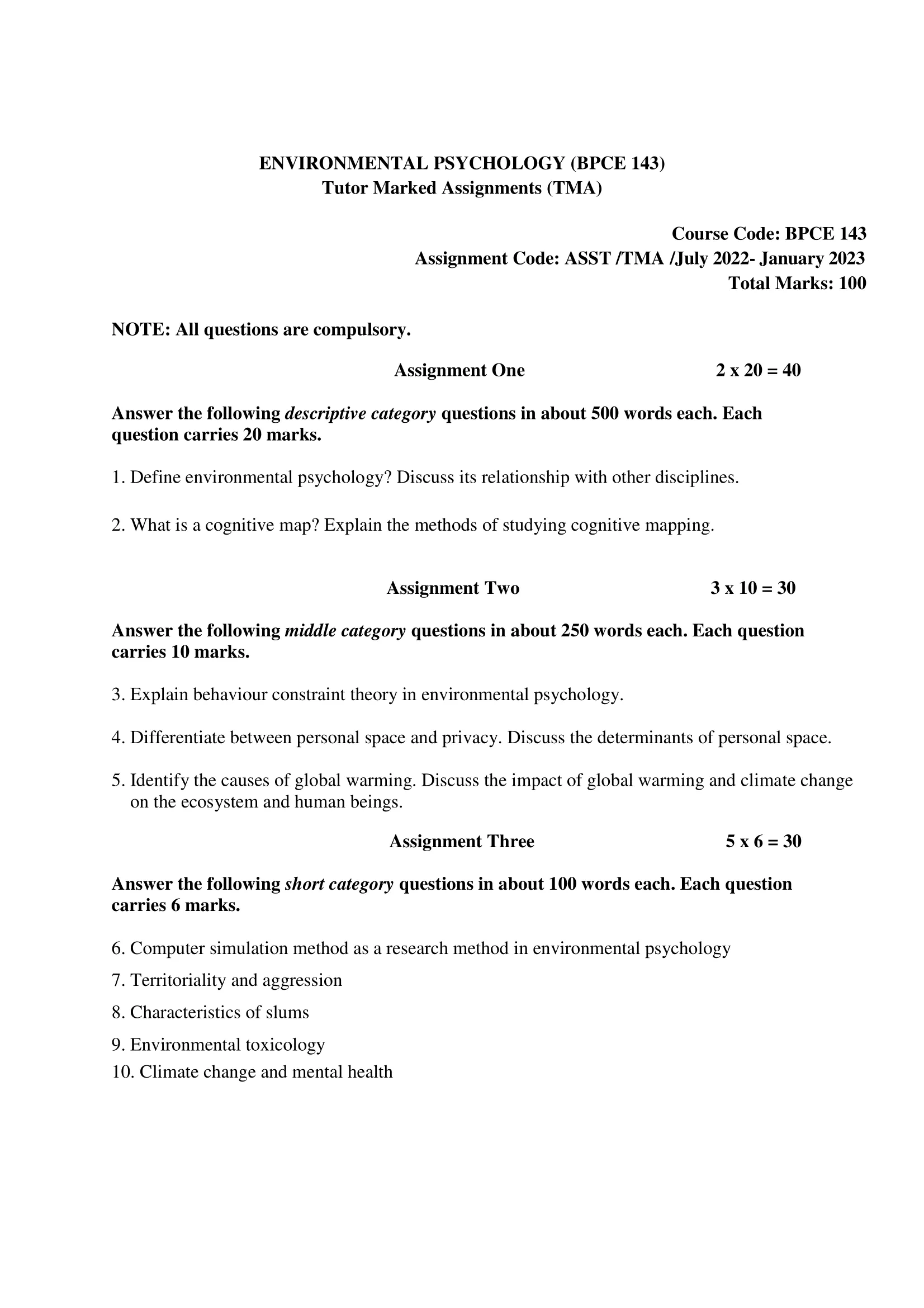Contents
- 1 Assignment One
- 2 Answer the following descriptive category questions in about 500 words each. Eachquestion carries 20 marks.
- 3 1. Define environmental psychology? Discuss its relationship with other disciplines.
- 4 2. What is a cognitive map? Explain the methods of studying cognitive mapping.
- 5 Assignment Two
- 6 Answer the following middle category questions in about 250 words each. Each question carries 10 marks.
- 7 3. Explain behavior constraint theory in environmental psychology.
- 8 4. Differentiate between personal space and privacy. Discuss the determinants of personal space.
- 9 5. Identify the causes of global warming. Discuss the impact of global warming and climate change on the ecosystem and human beings.
- 10 Assignment Three
- 11 Answer the following short category questions in about 100 words each. Each question carries 6 marks.
- 12 6. Computer simulation method as a research method in environmental psychology.
- 13 7. Territoriality and aggression
- 14 8. Characteristics of slums
- 15 9. Environmental toxicology
- 16 10. Climate change and mental health

| Title | BPCE-143: IGNOU BAG Solved Assignment 2022-2023 |
| University | IGNOU |
| Degree | Bachelor Degree Programme |
| Course Code | BPCE-143 |
| Course Name | ENVIRONMENTAL PSYCHOLOGY |
| Programme Name | Bachelor of Arts (General) |
| Programme Code | BAG |
| Total Marks | 100 |
| Year | 2022-2023 |
| Language | English |
| Assignment Code | ASST /TMA /July 2022- January 2023 |
| Last Date for Submission of Assignment: | For June Examination: 31st April For December Examination: 30th September |

Assignment One
Answer the following descriptive category questions in about 500 words each. Each
question carries 20 marks.
1. Define environmental psychology? Discuss its relationship with other disciplines.
Ans: Environmental psychology is an interdisciplinary field that examines the interactions between human beings and their physical environment. It explores how humans experience, perceive, and respond to the environment around them, including the built environment, natural environment, and social environment. The discipline seeks to understand how these interactions affect human behavior, emotions, cognition, and overall well-being.
The field of environmental psychology draws on several other disciplines, including psychology, architecture, geography, sociology, and anthropology. It is an interdisciplinary approach to understanding the impact of the environment on human behavior and well-being. Environmental psychology has roots in both psychology and geography, with early researchers focusing on the impact of environmental factors on human behavior.
Environmental psychology overlaps with several other disciplines, including:
- Architecture: Environmental psychology and architecture share a mutual interest in the design of the built environment. Environmental psychologists study the ways in which environmental factors such as lighting, acoustics, and temperature influence human behavior, while architects apply these findings in designing buildings that enhance the well-being of occupants.
- Geography: Environmental psychology and geography share a common focus on the relationship between humans and the physical environment. Both disciplines study how people interact with the environment, with geographers focusing on the spatial patterns of human-environment interaction, and environmental psychologists studying the psychological and social factors that affect such interactions.
- Sociology: Environmental psychology and sociology both explore the social dynamics of human-environment interactions. Environmental psychologists investigate how social norms and expectations influence people’s behavior and perceptions of the environment, while sociologists study the social and cultural factors that shape people’s relationship with the environment.
- Anthropology: Environmental psychology and anthropology share an interest in understanding how people’s cultural and social backgrounds influence their relationship with the environment. Anthropologists study the ways in which different cultures perceive and interact with their environment, while environmental psychologists investigate the psychological processes underlying these perceptions and interactions.
2. What is a cognitive map? Explain the methods of studying cognitive mapping.
Ans: A cognitive map is a mental representation of an individual’s spatial environment. It is a mental model that allows people to navigate their physical environment and orient themselves in space. The concept of cognitive maps was first introduced by psychologist Edward Tolman in the 1940s, who argued that animals, including humans, form cognitive maps that allow them to navigate and make decisions in their environment.
The study of cognitive mapping is a key area in the field of environmental psychology and has been approached through various methods. Some of the most common methods used to study cognitive mapping are:
- Verbal reports: One of the most straightforward ways to study cognitive maps is to ask individuals to describe their mental representation of a given environment. Researchers can ask participants to describe a route they have taken or to draw a map of a familiar location. This method is useful in revealing the general structure of cognitive maps and the spatial relationships between different landmarks.
- Behavioral measures: Cognitive maps can also be inferred from people’s behavior in a given environment. For example, researchers can ask participants to navigate a maze or a virtual environment and then measure their speed and accuracy in finding their way. This method can reveal how cognitive maps influence people’s behavior and decision-making.
- Physiological measures: Cognitive maps can also be studied using physiological measures, such as brain imaging. fMRI (functional magnetic resonance imaging) and other neuroimaging techniques can reveal which areas of the brain are activated when individuals engage in spatial navigation or recall information about a given environment. This method is useful in understanding the neural mechanisms underlying cognitive maps.
- Environmental simulations: Another approach to studying cognitive mapping is to create simulations of real or hypothetical environments. Participants can be asked to navigate these simulations, and their behavior and verbal reports can be used to infer their cognitive maps. This method is useful in understanding how people form and use cognitive maps in complex or unfamiliar environments.
Assignment Two
Answer the following middle category questions in about 250 words each. Each question carries 10 marks.
3. Explain behavior constraint theory in environmental psychology.
Ans: Behavior Constraint Theory is an approach in Environmental Psychology that focuses on the relationship between environmental factors and human behavior. This theory suggests that the physical characteristics of the environment can influence people’s actions and decisions by constraining or enabling certain behaviors. It assumes that the environment provides cues and information that people use to guide their behavior.
According to this theory, environmental constraints can be categorized into three types: physical, social, and organizational. Physical constraints refer to the physical properties of the environment that limit or facilitate behavior, such as the size and layout of a room or the presence of barriers or obstacles. Social constraints refer to the social norms and expectations that influence behavior, such as the behavior of others in a group or the cultural expectations of a particular community. Organizational constraints refer to the rules and policies that govern behavior, such as the regulations of a workplace or the policies of a government agency.
Behavior Constraint Theory suggests that people’s behavior is a result of their interaction with the environment. When environmental constraints are aligned with desired behaviors, individuals are more likely to engage in those behaviors. Conversely, when environmental constraints are misaligned with desired behaviors, individuals may be less likely to engage in those behaviors.
For example, a workplace that provides easy access to healthy food options and encourages physical activity can promote healthy behavior among employees. In contrast, a workplace that provides limited healthy food options and does not encourage physical activity may constrain healthy behavior.
4. Differentiate between personal space and privacy. Discuss the determinants of personal space.
Ans: Personal space and privacy are two important concepts in environmental psychology that are often used interchangeably, but they are different in meaning and application.
Personal space refers to the physical distance and territorial boundaries that individuals maintain around themselves. It is the area around a person that they consider as their own and it is important for their sense of comfort, security, and well-being. The size and shape of personal space can vary depending on cultural norms, social situations, and individual preferences.
Privacy, on the other hand, refers to the ability to control access to personal information or activities. It is a subjective and culturally dependent concept that involves the right to be left alone or to maintain control over certain aspects of one’s life. Privacy can be physical, such as the ability to close a door, or informational, such as controlling access to personal data.
The determinants of personal space are varied and can include both physical and psychological factors. Physical factors include the size and layout of the environment, the density of people in a space, and the level of noise and activity. Psychological factors include the cultural norms and social expectations of a group or community, the individual’s personality, and their past experiences.
The size and shape of personal space can also be influenced by gender, age, and social status. For example, research suggests that men generally prefer larger personal space than women, and that older people prefer more personal space than younger people. Social status can also influence personal space, as individuals with higher social status may have more control over their personal space and be able to maintain larger territorial boundaries.
5. Identify the causes of global warming. Discuss the impact of global warming and climate change on the ecosystem and human beings.
Ans: Global warming is the long-term increase in the average temperature of the Earth’s climate system, primarily caused by the release of greenhouse gases, such as carbon dioxide, methane, and nitrous oxide, into the atmosphere. The major causes of global warming include:
- Human activities: Burning fossil fuels for energy, deforestation, industrial processes, and agriculture are major human activities that emit greenhouse gases into the atmosphere.
- Natural factors: Natural factors such as volcanic eruptions, changes in solar radiation, and natural fluctuations in the Earth’s climate can also contribute to global warming, but these factors are not significant compared to human activities.
The impacts of global warming and climate change on the ecosystem and human beings are significant and far-reaching. Some of the major impacts are:
- Melting of ice caps and glaciers: Rising temperatures are causing the melting of ice caps and glaciers, leading to sea level rise and coastal flooding.
- Changes in precipitation patterns: Changes in precipitation patterns are leading to more frequent and intense extreme weather events, such as droughts, heatwaves, and heavy rainfall, which can cause flooding and landslides.
- Impacts on biodiversity: Changes in temperature and precipitation patterns are causing shifts in the geographic range and timing of species, leading to changes in the composition and distribution of ecosystems.
- Human health impacts: Climate change is leading to the spread of diseases, as rising temperatures create more favorable conditions for the spread of disease-carrying insects and animals.
- Economic impacts: Climate change is leading to economic impacts such as crop failures, reduced productivity, and damage to infrastructure.
Assignment Three
Answer the following short category questions in about 100 words each. Each question carries 6 marks.
6. Computer simulation method as a research method in environmental psychology.
Ans: Computer simulation is a research method used in environmental psychology to create digital models of physical environments. These models can be used to study how people interact with the environment, and how environmental factors such as lighting, temperature, and noise affect behavior and well-being. By simulating different scenarios, researchers can test the impact of environmental variables on human behavior in a controlled and systematic way. Computer simulation is a useful research method in environmental psychology as it allows for the manipulation of environmental factors that may be difficult or impractical to manipulate in the real world.
7. Territoriality and aggression
Ans: Territoriality is a behavior exhibited by animals, including humans, where individuals claim and defend a physical space as their own. Territoriality can lead to aggression towards individuals who intrude into the claimed space. In environmental psychology, territoriality is studied in relation to human behavior in various environments, such as homes, workplaces, and public spaces.
Aggression can occur when someone intrudes into another’s territory, as this can be perceived as a threat to the individual’s security and sense of control over their environment. Territorial aggression can manifest in different forms, ranging from mild behaviors such as staring or verbal confrontations to more severe forms, such as physical violence. Environmental psychologists study the factors that contribute to territoriality and territorial aggression, such as the size and characteristics of the claimed space, the personality traits of the individuals involved, and the cultural and social norms surrounding territorial behavior. By understanding the factors that contribute to territoriality and aggression, researchers can develop strategies to promote positive territorial behaviors while reducing the negative impact of territorial aggression.
8. Characteristics of slums
Ans: Slums are generally characterized by poor living conditions, inadequate housing, and lack of basic amenities such as clean water, sanitation, and healthcare. Some of the common characteristics of slums include:
- Overcrowding: Slums are often characterized by high population density and overcrowding, with many people living in small, cramped spaces.
- Poor housing conditions: The housing in slums is often inadequate and substandard, with inadequate ventilation, poor insulation, and lack of basic amenities such as running water and electricity.
- Lack of basic services: Slums often lack basic services such as clean water, sanitation, healthcare, and education.
- High levels of poverty: Slums are often associated with high levels of poverty and unemployment, with many residents struggling to make ends meet.
- Limited access to resources: Slum dwellers often have limited access to resources such as land, capital, and social services, which can make it difficult for them to improve their living conditions.
- Insecurity and violence: Slums are often associated with high levels of crime, violence, and social unrest, with residents facing threats from gangs, drug dealers, and other criminal elements.
9. Environmental toxicology
Ans: Environmental toxicology is the study of how pollutants and other harmful substances impact the environment and the organisms that inhabit it. It is an interdisciplinary field that draws on knowledge from toxicology, ecology, chemistry, and other sciences to understand the sources, fate, and effects of toxic substances in the environment.
Environmental toxicology encompasses a wide range of issues, including air pollution, water pollution, soil contamination, and the effects of pesticides and other chemicals on wildlife and human health. It is concerned with the ways in which toxic substances enter the environment, how they are transported and transformed, and how they affect the health and well-being of living organisms.
Some of the key areas of research in environmental toxicology include:
- Hazard identification: Identifying the hazards of toxic substances and their potential effects on the environment and human health.
- Exposure assessment: Determining how toxic substances are released into the environment, how they move through the environment, and how organisms are exposed to them.
- Toxicokinetics: Understanding how toxic substances are absorbed, distributed, metabolized, and eliminated by living organisms.
- Risk assessment: Evaluating the potential risks associated with exposure to toxic substances and determining appropriate risk management strategies.
Environmental toxicology plays an important role in identifying and managing environmental hazards, informing environmental policy, and protecting the health and well-being of humans and other organisms. By understanding how toxic substances impact the environment and living organisms, we can develop strategies to minimize exposure and reduce the risks associated with environmental toxins.
10. Climate change and mental health
Ans: Climate change is having a significant impact on the environment and human health, including mental health. The impacts of climate change, such as extreme weather events, rising sea levels, and increasing temperatures, are leading to stress, anxiety, depression, and other mental health problems.
Some of the ways that climate change can affect mental health include:
- Trauma and stress: Natural disasters, such as hurricanes, floods, and wildfires, can lead to physical and emotional trauma, stress, and anxiety.
- Displacement and migration: Climate change can lead to displacement and migration, as people are forced to leave their homes due to environmental disasters or changes in their natural resources. This can lead to feelings of displacement, loss, and uncertainty.
- Economic impacts: Climate change can lead to economic impacts such as crop failures, job losses, and damage to infrastructure, leading to financial stress and anxiety.
- Health impacts: Climate change is leading to the spread of diseases, which can lead to increased anxiety and stress.
To address the mental health impacts of climate change, it is important to develop strategies that focus on building resilience and supporting mental health. Some potential strategies include:
- Developing community-based interventions that focus on building resilience and promoting mental health.
- Providing access to mental health services, including counseling, therapy, and other support services.
- Addressing the root causes of climate change, including reducing greenhouse gas emissions and promoting energy efficiency and conservation.
- Providing education and information about climate change and its impacts, including how to build resilience and cope with the effects of climate change.
How to Download BPCE-143 Solved Assignment?
You can download it from the www.edukar.in, they have a big database for all the IGNOU solved assignments.
Is the BPCE-143 Solved Assignment Free?
Yes this is absolutely free to download the solved assignment from www.edukar.in
What is the last submission date for BPCE-143 Solved Assignment?
For June Examination: 31st April, For December Examination: 30th October












![[Solved Assignment] BPCS 188-APPLICATIONS OF SOCIAL PSYCHOLOGY (IGNOU-BAG) 2022-2023 BPCS 188-APPLICATIONS OF SOCIAL PSYCHOLOGY IGNOU BAG Solved Assignment 2022-2023](https://edukar.org/wp-content/uploads/2023/01/BPCS-188-APPLICATIONS-OF-SOCIAL-PSYCHOLOGY-IGNOU-BAG-Solved-Assignment-2022-2023-1024x640.webp)


